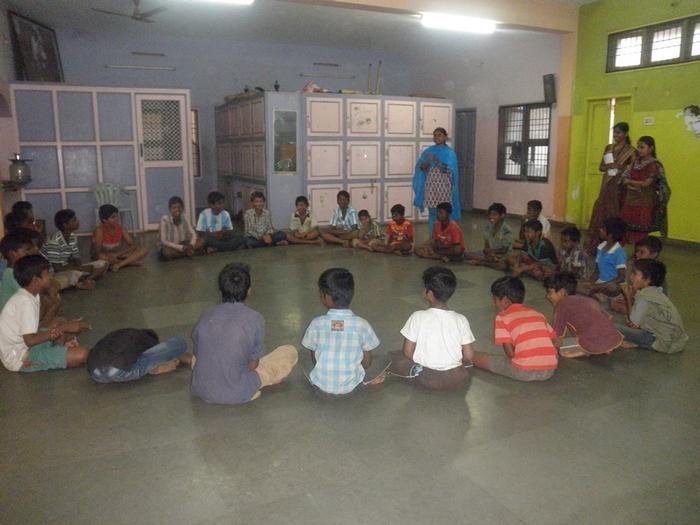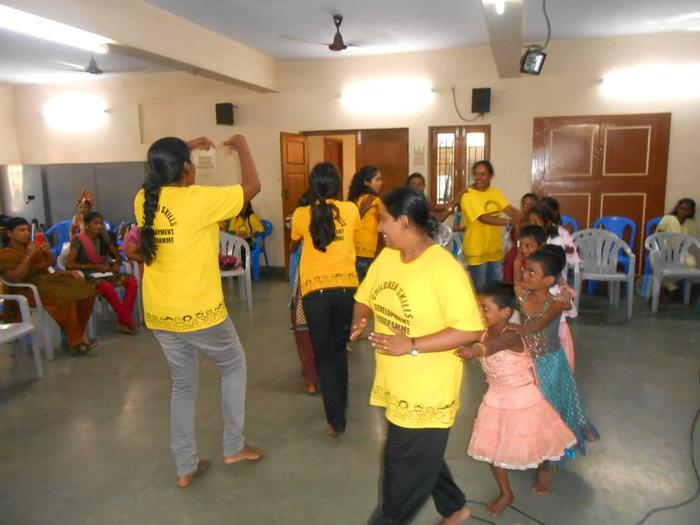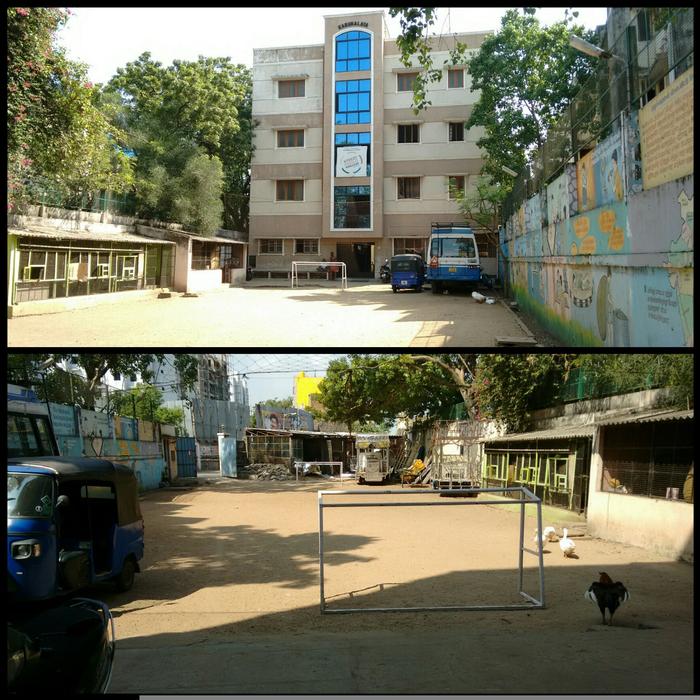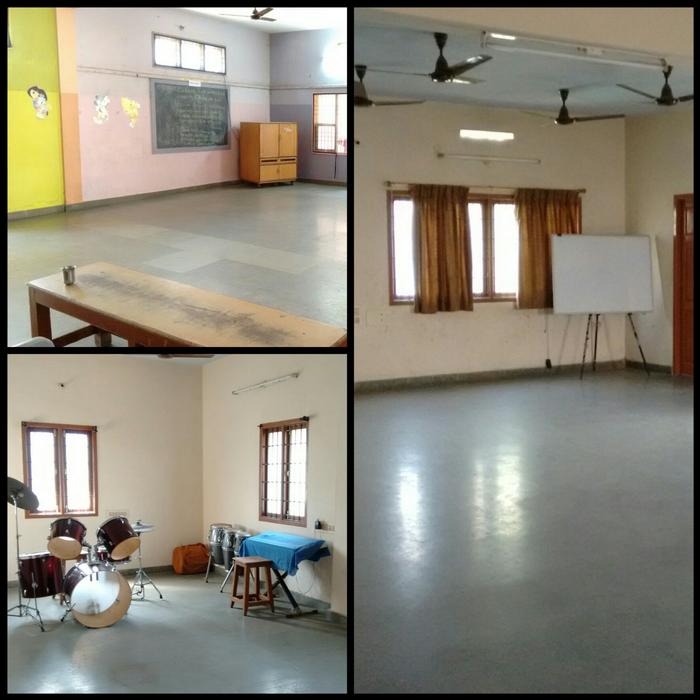[ID:1680] Paving better paths for little feetIndia It is 7 am. The telltale railway announcement comes, as every day, with its clamorous wave of school and college students, office goers and hawkers racing their way to their destinations. Mohan sits on the platform, looking hungrily at every passing pair of feet. It has been almost fourteen hours since his last meal, one of stale bread he was lucky to chance upon behind the food stalls. The hawkers are unkind. Mohan has been victim to many of their fists and sticks. Nowadays, he just lingers desperately, hoping to find a lost lunch box or leftovers from the trash bins. Occasionally, he slips his hand into the bag of an unsuspecting schoolchild but he tries not to risk it. The policemen are more brutal than the hawkers. As a starving Mohan sits on the platform, watching the train’s wheels turning, a city chugs along, oblivious to the thousands of Mohans walking through its streets, struggling through each day.
Fleeing from physical and sexual abuse at home or leaving their rural homes under the weight of poverty and in search of jobs, or abandoned by their families, children from across the country wind up on the streets of metropolises like Chennai. Bereft of security and parental supervision, the unknowing street children become subject to abduction, rape and trafficking. Violence towards these children by police officers and the general public is a regular aspect of their life. The general treatment these children receive from the common people is rarely sympathetic. These factors become the cause of the children’s untrusting attitude towards people. Also, their stressful and traumatic lifestyle on the streets drives them to substance and alcohol abuse, delinquency and violence.
Transforming the lives of the street children of Chennai’s beaches, streets, railway stations, bus stops and the harbour is the raison d’être of Karunalaya, a social service organization run by Dr. Paul Sunder Singh. Presently, the two shelters run by Karunalaya are home to 36 boys and 29 girls respectively. Both the shelters follow the same spatial order. My primary study concentrates on the boys’ shelter and the inferences drawn from my analysis are applicable to both shelters.
At Karunalaya, an organized rescue method is followed. Street children are identified by the rescue officials, who after speaking to them, bring them to the shelter. Here, a counsellor interacts with the children and attempts to uncover their background. This usually proves difficult as the children refuse to divulge their true identities in fear of being harmed or returned to the dangerous living conditions from which they have escaped. These children then become part of the shelter. They are enrolled in schools and the activities assigned to them at the shelter seek to provide them a healthy childhood. They aim to ultimately make the children self-sufficient by the age of 18, equipping them to earn a living in the city.
The design of the shelter itself aids in this endeavour. The Karunalaya shelter for street children is located in North Chennai, where its rescue work began. Though the shelter is situated less than a kilometre from the fishing harbour, it is nestled in a residential neighbourhood, which provides the children a secure setting to walk around in. It is fronted by a small playground, used primarily for football practice by the children. When I walked across the playground and towards the building the first time, I was greeted by a large banner for Street Children’s World Cup and the cackling of hens. One side of the playground is bordered by a row of chicken coops. The coops, I learnt later from the warden, were put up by the children themselves. The animals help the children to develop feelings of sympathy that were so far perceivably inconspicuous in them. So, this step by the children was a milestone in their recovery process.
The counsellor’s room is the first upon entry into the building. After the initial interaction here with the counsellor, the child moves into the shelter as one of its new residents. Immediately beyond the notice board outside the counsellor’s office, is a large multipurpose hall that serves as the gathering space, dining space and learning space. It is also the sleeping quarters for children below 12 years of age. By centralising most of the children’s activities in a common space rather than private ones, a neighbourly atmosphere is created instead of a reclusive one. As this setting promotes group activities, like studying, playing and exercising together, and communal eating, it induces in the child a sense of social responsibility. Apart from the counsellor’s room and the hall, the ground floor consists of the bathrooms and toilets for the children.The first floor contains administrative offices and storage rooms. The second floor consists of a second hall that is used solely as sleeping quarters for the older children, 12-18 years of age. A third hall on the third floor is used to conduct yoga and dance classes and personality development programs. Christmas, New Year and other celebrations also take place in this hall. A music room housing various instruments is adjacent to this hall. A clear vertical segregation is followed in the arrangement of spaces. The most used spaces are concentrated on the ground floor while the higher floors are reserved for less frequent use. The spaces on the ground floor are directed to throw emphasis on the playground. The building and playground are enclosed by a high compound wall. This creates a strong demarcation between the external streets and the shelter. It ensures safety of the residents but the wide gates that are kept open through the day also give them the opportunity to interact with the outside. The painted compound walls at Karunalaya depicting figures of children give a vibrant character to the playground. The predominantly cool colours set a pleasant ambience. Use of visual elements like colour have a great influence on space as demonstrated by Architect Scott Knox in his temporary shelter design for the Kumbh Mela in India. The houses, all following a standard module, are differentiated from one another by use of colour and paintings of fruits and flowers on the external walls.
Open spaces have significant impact on the physical, mental and social wellbeing of children. At the most basic level, the playground serves as a place to exercise and practice team games, thus promoting interaction. This sets the stage for increasing social cohesion and social inclusion in the long term. Additionally, open spaces provide a sense of community pride. In the context of the street children, this is crucial as it gives them a sense of identity, which is infeasible on the streets.
In Karunalaya, the multipurpose nature of the spaces gives them a flexibility that allows the children to explore different possibilities. There is no fixed furniture that dictates the use of a space. The children are given the freedom to choose what they do and how they work in a given space, thus providing them an unrestricted environment that helps in developing their imagination. In shelters for kids, the number of users is in direct relation to the area of the shelter. High-density environments that have too many children and too little space can prove to be stressful for the children, as discovered by behavioural sciences expert, Wohlwill and sociologist, Van Vliet. This is one of the reasons the shelters at Karunalaya are successful. This helps minimizing bullying, grouping and internal conflicts among children.
One of the key differences I identified in the housing of street children versus other shelters for the homeless is the permanent quality of shelter that is required for the former. The shelter for children is less transient in nature compared to other shelters because of two reasons – the length of stay and its psychological effect on the kids. Prior to rescue, the street children live a nomadic and unsettled life, which strips them of a healthy childhood necessary for building moral and social values like integrity, honesty and social responsibility. A homelike atmosphere has to be achieved, which combines public, private and open spaces such that the space provides security and the child does not find his surroundings unfamiliar or intimidating.
Though the four-storey height of the building is balanced by adequate open space in front, as an architect, I would prefer to restrict the vertical expanse and instead spread the different spaces out on a horizontal plane, interspersed by open spaces. This vertical restriction is in order to create a building that is relatable to the human scale and is not intimidating to its residents, as the primary residents are children. Shorter structures reinforce residential character in the space. As the ideal location for the shelter would be a residential area, this type of massing would ensure that it does not stand out in the environment. Also, inclusion of green open spaces is desirable as they are more child-friendly than barren spaces. A recent study by the Centre for Research in Environmental Epidemiology, Barcelona affirmed that they increase cognitive activity in children and at a more conscious level, create a comfortable learning and playing zone.
“Blending in” is another key factor to be acknowledged in the design of the shelter. In Chennai, residential construction happens chiefly with bricks and reinforced cement concrete. Buildings are then plastered and painted over. Though high-rise construction is growing substantially in the southern parts of the city, especially the outskirts, and apartments of up to ten-storey height are common in many parts of the city, a significant number of residential zones still house only two or three-storeyed structures. This led me to deduce that use of foreign materials or styles does not only disturb the integrity of the urban fabric, but also creates an alien environment for the children which they would not relate to, for lack of familiarity. The style of architecture should be consistent with that of the surrounding built environment. Thus, I believe that locally available building materials should be used, ideally.
In Architect Aldo van Eyck’s Weeshius (Amsterdam orphanage), a series of inter-connected free-flowing open spaces (indoor streets) that encourage interaction are at the core of the design. The exclusiveness of the open spaces to the children also provides security. In the architect’s words, “a house must be like a small city if it’s to be a real house, a city like a large house if it’s to be a real city”. This idea is evident in the design of the orphanage. The architect has created a number of buildings with each of them having their own open space and importantly, retained the residential character in the complex. In comparison to the layout followed at Karunalaya, Eyck’s model provides more scope for interaction and exploration to the children.
In the eyes of the common man, street children are either helpless victims of hunger and violence or drug-taking criminals lacking morality and respect for the social order, as stated by Sarah Thomas de Benitez in “State of the World’s Street Children”. The latter is, notably, the more common stereotypical characterization.
A calamity of monstrous proportions ravaged Chennai in the final weeks of 2015, creating, on one hand, an unprecedented amount of destruction and on the other, a marked alteration in the city’s attitude towards the homeless. Chennai, which receives an average of 409 mm of rainfall during the month of November, received 1049 mm of rainfall in the November of 2015, the highest since 1918. The subsequent floods killed more than 300 people and left about 1 million people displaced from their homes.
The city’s response to the displacement was overwhelming. More than a thousand homes opened their doors to shelter the affected people. Most importantly, the city’s attitude towards the homeless has undergone a remarkable change. With this as the first step towards providing a better home for the street children of the city, as an architect, I wish to collaborate with the government to secure a permanent space in the society for the children by creating a series of shelters for them across the city. I also wish to collaborate with the NGOs and grassroots organizations working with street children in Chennai, and apply my inferences from this study to create spaces for them. The shelters shall work in association with the government and private schools of their respective areas and in essence, achieve across the city, what is being carried out at Karunalaya. The inferences I have drawn from studying Karunalaya have given me insight into the lives of street children from a first-person perspective. Especially in a design this sensitive, it is essential that the architect does not only respond to the needs of the users but fulfils their rights as well. The shelters shall contain, in addition to living and playing spaces, libraries and computers, necessities of the modern world the children do not have access to. I wish to work, not only as an architect, but as a worker for the welfare of the children. My aim is to get equal opportunities for the street children as other children in the city. The children shall be provided training to participate in different events, ranging from sports to academics to music and arts. The shelters shall also conduct public events like marathons that allow the children to interact directly with the public and builds skills of organizing and teamwork in them. In effect, the shelters would ensure a holistic development of the children. Their participation would establish their presence in the public sphere and thus, increase people’s awareness of their situation. Awareness is the first step to change, and as Chennai has demonstrated its supportive spirit during the floods, I believe that the city will raise to the cause of the street children. As Nelson Mandela once said, “There can be no keener revelation of a society’s soul than the way in which it treats its children.”
As an architect, I believe that one of architecture’s greatest successes is its role in shaping a person’s identity. As I walked out of the boys’ shelter, the warden excitedly pointed to the notice board at the entrance. On it were photos of boys in football jerseys, smiling into the camera, hands over each other. The boys of Karunalaya, I learnt, had gone to Brazil to represent India in the Street Children Football World Cup. As I looked at rows of pictures of footballers, karate champions and cricketers, the two boys who had been playing in the ground until then, looked at each other and smiled proudly, their chests puffing up. Karunalaya has given them more than just sustenance. It has given them a reason to be proud of themselves, the confidence to face the world and the opportunity to realise their potential, which every child deserves. I walked out, the vision of the proud boys imprinted in my eyes. If any architecture has the power to bring such change to lives, that is a successful architecture.
If you would like to contact this author, please send a request to info@berkeleyprize.org. |




